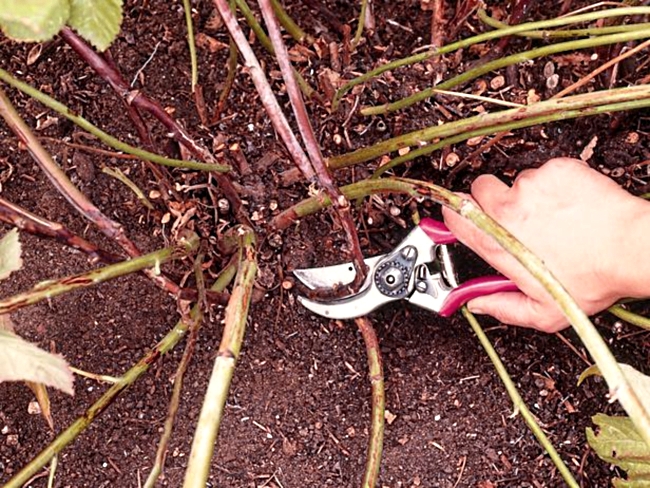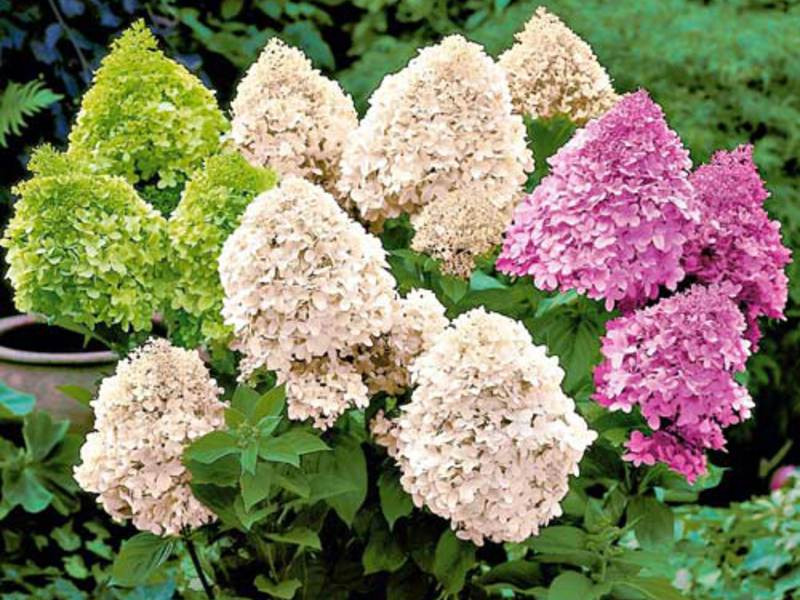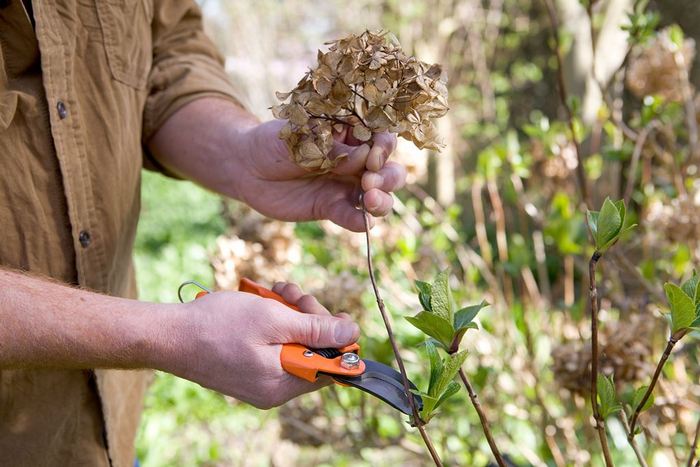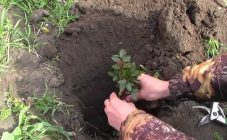Content:
All varieties of hydrangeas can decorate a garden, a summer cottage, diversify the landscape design in squares, on lawns. For the plant to be attractive and neat, proper care is needed, including periodic pruning of the hydrangea.
Types of pruning bushes
Hydrangea is a tree-like shrub. It is distinguished by a large number of shoots that are added to the plant every year. Many gardeners are interested in how to shorten the branches so as not to injure the tree and stop flowering.
Pruning a tree hydrangea cannot harm the bush, because most of the inflorescences can be seen at the ends of the twigs formed this year, as well as on the most persistent zero (i.e. underground) twigs. Therefore, you can safely use all the main types of pruning that are used for most bushes:
- Sanitary. Provides for the removal of parts that are already unnecessary and unnecessary for the plant. For hydrangea, such, for example, can be: frozen shoots at the end, dried, broken branches, as well as processes of atypical color.
- Thinning. Provides for the removal, first of all, of weak zero shoots, as well as small shoots that grow towards the center of the bush and those that will never bloom again.
- Anti-aging. Provides for the removal of those branches that are already more than 3-4 years old, but did not bloom in the previous year.
- Pruning for flowering. It is performed in order to add more strength to the bush. Provides for the removal of only a certain part of the branch (for example, frozen ends). There must be at least 2-4 pairs of strong kidneys.
When to prune hydrangea
Spring is the best time to prune hydrangeas. Although at this time there are also difficulties with the process of updating the bush (for example, tight deadlines for completing work, shifting the phases of plant growth), meanwhile, spring pruning provides:
- great appearance of the bush;
- speed and simplicity of the process (in the spring it is easier to distinguish damaged parts from fresh ones);
- good flowering;
- very low probability of freezing of shortened shoots.
Telling how to prune a hydrangea, experienced specialists point out that such work can be done very early in spring, even if there is still a slight layer of the last snow on the street. However, it is very important to adhere to several conditions:
- Work should be done only when the growth buds have already swollen. According to them, you can determine which branches are worth getting rid of and which ones should be left. As a rule, in most regions of Russia, this period falls in mid-March - early April.
- Consider the variety of the bush. Treelike hydrangea should be pruned as early as possible. The optimal period for this species is March. This is due to the slow growth of the plant and the long recovery period of the shoots. Paniculata, on the other hand, loves late cleaning more. April is good for her.
- Weather.Every beginner, interested in the question of how to prune a hydrangea, should know that even if the buds of the bush have already swollen, but the cold has returned to the region, pruning must definitely be abandoned.
Pruning hydrangeas in the fall can be problematic. Inexperienced gardeners do not need the autumn cutting process at all. A decrease in frost resistance, the development of plant diseases are not the only consequences of poor-quality pruning. The cuts themselves may not last until the onset of frost, then the whole bush may die.
When thinking about how to cut a hydrangea for the winter, you should first find out the features of the hydrangea variety, and also ask about the weather forecast.
Climatic features of pruning
For different regions, the periods and cardinality of cutting the bush should be different. So, for most regions (including the Moscow region), spring shortening can be performed as soon as the buds swell - in March-April, or in October, while the temperature outside is kept at 9-15 degrees with a plus mark.
In the southern regions, it is allowed to shorten the hydrangea bushes in early March, as well as in November.
The specifics of pruning hydrangea
How to shorten paniculatayu hydrangea
The owners will not have to spend too much time and effort on the panicle hydrangea in the fall. The owner just needs to remove the dried inflorescences.
In the spring (preferably in March), regular sanitization should be performed. In addition to broken, damaged shoots, young shoots should also be removed, but be sure to leave 3-5 pairs of buds on them. The more massive the bush is, the more buds you need to leave on it.
Old bushes can be shortened more radically. The panicle hydrangea has a tendency to thicken and have numerous branches that drain the bush. For this reason, the shortening of all last year's branches is also encouraged.
If anti-aging pruning is carried out, you need to get rid of all the shoots, but leave a few strong ones growing outward.
Crown formation
Answering the question of how to form a hydrangea, first of all, it is worth saying that this should be done in the spring. Formation can be done when the bush itself is already 2-3 years old.
It is necessary to remove, first of all, damaged and weak shoots. On the entire bush, you only need to leave 3-5 shoots, which grow independently in a vertical direction at an angle of 30 degrees. To prevent the crowns from turning in the wrong direction, they should be fixed on special supports. The latter are installed at an angle of 30 degrees.
Further, every year it will be necessary to remove the lower shoots, but leave only the upper ones, as well as several pairs of the highest buds. In the new season, you need to leave the upper, but shorten the lower side shoots that were formed last year by a ring.
Throughout the summer, the owner will have to monitor the appearance of new central shoots. Do not expect their woodiness, remove immediately. Thus, pruning must be carried out until the bush reaches its desired height. As a rule, this does not take more than 2-3 years.
Formative pruning should be done annually, throughout the life of the plant.
Pruning large-leaved hydrangea
Large-leaved hydrangea is a heat-loving shrub.Throughout the life of the bush, new zero shoots are formed on it. Older are considered to be more than 4-5 years old. Flowering occurs on new (grown this year) shoots that were formed on the basis of last year.
Since the plant is very fond of warmth and does not like to be touched before the cold season, in autumn it is only allowed to remove dried inflorescences. It is generally better to refuse winter pruning of the bush.
Sanitary pruning is done in early spring. Experienced gardeners do not advise to shorten last year's shoots of large-leaved hydrangea, because it is on them that flower buds are placed. The pruning scheme provides for the complete removal of old and dry branches on the ring. A novice housewife or owner should work carefully with pruning shears and cut at right angles.
About a quarter you need to get rid of those branches that have many lateral processes. The shortening of skeletal branches encourages the emergence of new branches from the base, helps the bush to become thicker and more lush.
The rejuvenating pruning of large-leaved hydrangea is needed by the bush once every 4-5 years. In this case, you need to trim the branches at a height of 30-40 cm from ground level.
Specificity for different species
Gardeners distinguish two main groups of hydrangeas:
- The first one includes those varieties that bloom on shoots formed since last year. Such a group, for example, includes oakleaf, serrate, large-leaved and liana-shaped hydrangeas.
- The second group includes varieties blooming on new (this year) shoots.
This should include paniculate, tree-like varieties.
Each of the varieties has its own peculiarity of crown formation. Cutting schemes for the most popular varieties should be indicated.
Instructions for pruning a tree hydrangea
- Removing inflorescences.
- Sanitary cleaning - removal of broken and frozen ends.
- Thinning is the removal of zero level shoots that are no longer able to bloom.
- Rejuvenation - the most complete removal of old shoots.
- Cutting for flowering - reduction of last year's shoots (by about 3-4 pairs of buds).
Scheme for panicle hydrangea
- Complete removal of conical inflorescences.
- Sanitary cleaning - you only need to get rid of dried particles of shoots (this variety is frost-resistant, so it does not have frozen shoots).
- Trimming strong shoots to increase additional young ones.
- Rejuvenation - you need to get rid of those branches that no longer grow in length.
- Vacuum - you need to remove unnecessary shoots, which make the bush sloppy and too overgrown.
Large-leaved hydrangea haircuts
- Removal of faded shoots that are more than two years old. You need to leave new shoots that have not yet given color.
- Sanitary cleaning - complete removal of frozen, dead and damaged branch-branches.
- Rejuvenation - removal of perennial parts.
- Depression - removal of weak and small processes.
Pruning hydrangeas of different ages
Experienced gardeners willingly share secrets and give their recommendations to beginners about how to properly prune hydrangeas of different ages:
- It is allowed to start shortening and forming a garden bush such as a hydrangea when the plant is 2-3 years old. Until that time, the plant needs to successfully adapt to the conditions, therefore it does not need extra stress.
- The first haircut should be light, crown-forming.
- The first pruning for seedlings provides for the shortening of individual shoots to a length of no more than 1/3 of the total shoot growth. In strong young shrubs, 1/5 of the total length can be cut.
- The next pruning of a young bush is needed so that it has good growth and flowering. This is carried out as planned - in March-April. You need to remove last year's increments.It is important to form a skeletal solid foundation.
- An adult bush is considered at the age of 3 years. Then you can perform all the recommended types of circumcision:
- Thinning is the removal of branches and shoots that interfere with the plant's appearance and make it too thick.
- Removal of damaged, weak, frozen and dried parts.
- Stimulating - shortening of last year's growths by about 2-4 buds in length.
- Rejuvenation - haircuts of all shoots, except for the 6-10 strongest ones.
Knowing the features of pruning hydrangeas, the owner will be able to provide his garden bush with a well-groomed and attractive look, as well as prolong his life.
















